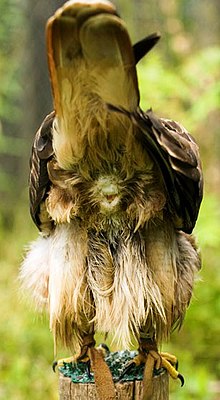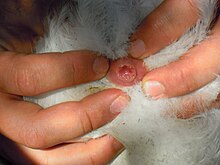Cloaca

A cloaca (
The cloacal region is also often associated with a secretory organ, the cloacal gland, which has been implicated in the scent-marking behavior of some reptiles,[1] marsupials,[2] amphibians, and monotremes.[3]
Etymology
The word is from the Latin verb cluo, "(I) cleanse", thus the noun cloaca, "sewer, drain".[4][5][6]
Birds



Birds reproduce using their cloaca; this occurs during a cloacal kiss in most birds.
One study[10] has looked into birds that use their cloaca for cooling.[11]
The cloaca in birds may also be referred to as the vent. Among falconers, the word vent is also a verb meaning "to defecate".
Fish
Among fish, a true cloaca is present only in
Mammals
With a few exceptions noted below, mammals have no cloaca. Even in the marsupials that have one, the cloaca is partially subdivided into separate regions for the anus and urethra.
Monotremes
The monotremes (egg-laying mammals) possess a true cloaca.[14]
Marsupials

In
Unlike other marsupials, marsupial moles have a true cloaca.[15] This fact has been used to argue that they are not marsupials.[16][17][unreliable source?]
Placentals
Most adult
Being placental animals, humans have an embryonic cloaca which divides into separate tracts during the
Reptiles
In reptiles, the cloaca consists of the urodeum, proctodeum, and coprodeum.
Cloacal respiration in animals
Some turtles, especially those specialized in diving, are highly reliant on cloacal respiration during dives.[23] They accomplish this by having a pair of accessory air bladders connected to the cloaca, which can absorb oxygen from the water.[24]
See also
References
- ISBN 978-0-226-28124-7.
- ISBN 978-1-4899-4656-0.
- ^ Harris, R. L., Cameron, E. Z., Davies, N. W., & Nicol, S. C. (2016). Chemical cues, hibernation and reproduction in female short-beaked echidnas (Tachyglossus aculeatus setosus): implications for sexual conflict. In Chemical Signals in Vertebrates 13 (pp. 145-166). Springer, Cham.
- ^ Cassell's Latin Dictionary, Marchant, J.R.V, & Charles, Joseph F., (Eds.), Revised Edition, 1928, p.103
- ^ Harper, Douglas. "cloaca". Online Etymology Dictionary.
- Perseus Project.
- ISBN 978-1-4214-2471-2.
- ISBN 978-0-8018-8687-4.
- ISBN 978-0-7923-8336-9. Archivedfrom the original on 26 March 2014. Retrieved 5 December 2012.
- PMID 17297135.
- .
- ^ ISBN 978-0-03-910284-5.
- Libbie Henrietta Hyman, A laboratory manual for comparative vertebrate anatomy. 1922 (1920s)
- ISBN 978-0-323-15331-7.
- .
- .
- ISBN 978-1-42143-733-0.
- S2CID 21132866.
- ISBN 978-1-4160-6477-0.
- ISBN 978-0-521-61714-7.
- ISBN 978-1-55209-605-5.
- JSTOR 3889486.
- ^ The Straight Dope - Is it true turtles breathe through their butts?
- ^ Aquarium Invertebrates by Rob Toonen, Ph.D.
